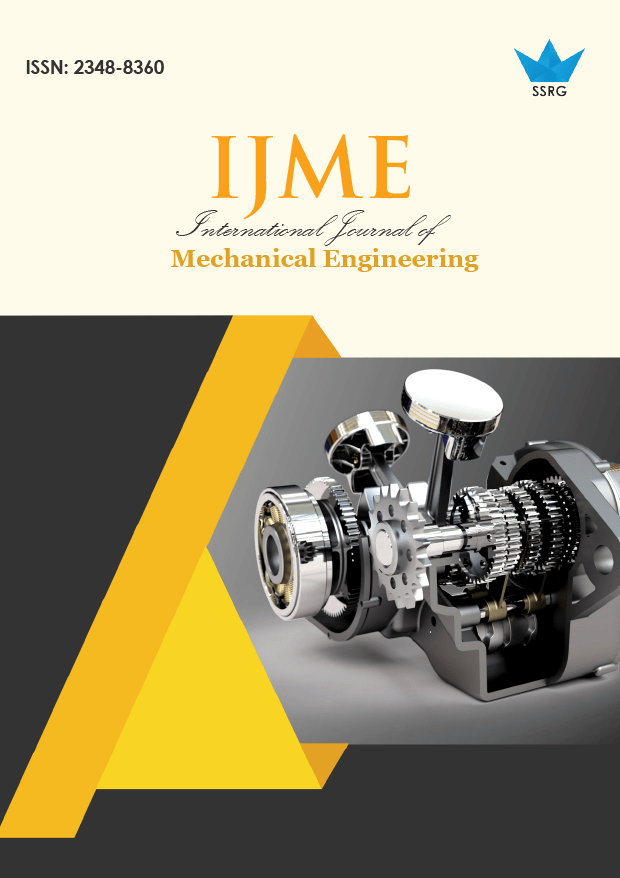Effect of Boundary Layer Trips on Low-Velocity Wind Turbine Blade: A Computational Study

| International Journal of Mechanical Engineering |
| © 2025 by SSRG - IJME Journal |
| Volume 12 Issue 3 |
| Year of Publication : 2025 |
| Authors : Suhas B.G, Anil Chandra A.R, Prema V, Sreejith B.K., Abdulrajak Buradi, Kiran Kumar K.U |
How to Cite?
Suhas B.G, Anil Chandra A.R, Prema V, Sreejith B.K., Abdulrajak Buradi, Kiran Kumar K.U, "Effect of Boundary Layer Trips on Low-Velocity Wind Turbine Blade: A Computational Study," SSRG International Journal of Mechanical Engineering, vol. 12, no. 3, pp. 28-35, 2025. Crossref, https://doi.org/10.14445/23488360/IJME-V12I3P102
Abstract:
This study focuses on designing wind turbines that can efficiently generate energy from low wind velocities. It investigates airfoils operating at low Reynolds Numbers (Re <500,000), where their performance often suffers due to Laminar Separation Bubbles (LSBs). The research applies passive methods to mitigate this effect and enhance blade efficiency. A site-specific analysis identified the design wind speed as 7.25 m/s at a hub height of 10 meters, adhering to IEC standards. The passive flow control method was employed to reduce LSBs and drag, thereby boosting the aerodynamic performance of the FX 63-137 airfoil. A 2D computational study evaluated the influence of rectangular-shaped BLTs on airfoil performance. The analysis considered various angles of attack and wind speeds (5.15, 7.25, and 10 m/s). The introduction of BLTs reduced total drag by approximately 14%. The lift-to-drag ratio (Cl/Cd) increased by roughly 12.3% at the design wind speed. The numerical analysis showed strong agreement with experimental data available in the literature, demonstrating the validity of the approach. This research confirms the effectiveness of boundary layer trips in improving aerodynamic performance under low wind speed conditions. The findings support the potential of this method to enhance the efficiency of small-scale wind turbines in regions with moderate wind resources.
Keywords:
Boundary Layer Trips, Laminar Separation Bubble, Passive techniques, Power generation, Small speed wind turbine.
References:
[1] Marcelo M.G. Dias, and Ramiro Gustavo Ramirez Camacho, “Optimization of NREL Phase VI wind Turbine by Introducing Blade Sweep, Using CFD Integrated with Genetic Algorithms,” Journal of Brazilian Society Mechanical Science Engineering, vol. 44, 2022.
[CrossRef] [Google Scholar] [Publisher Link]
[2] H. Dong et al., “Letter: A Note on Flow Characterization of the FX63-137 Airfoil at Low Reynolds Number Using Oil-Film Interferometry Technique,” Physics of Fluids, vol. 30, no. 10, 2018.
[CrossRef] [Google Scholar] [Publisher Link]
[3] Hao Dong et al., “Study on Flow Separation and Transition of the Airfoil in Low Reynolds Number,” Physics of Fluids, vol. 31, no. 10, 2019.
[CrossRef] [Google Scholar] [Publisher Link]
[4] Mustafa Serdar Genç, Kemal Koca, and Halil Hakan Açikel, “Investigation of Pre-Stall Flow Control on Wind Turbine Blade Airfoil Using Roughness Element,” Energy, vol. 176, pp. 320-334, 2019.
[CrossRef] [Google Scholar] [Publisher Link]
[5] Renewables 2020: Analysis and Forecast to 2025, IEA, 2020. [Online]. Available: https://www.iea.org/reports/renewables-2020
[6] IEC 61400-2, Wind Turbines - Part 2: Small Wind Turbines, International Electrotechnical Commission, 2013. [Online]. Available: https://webstore.iec.ch/en/publication/5433
[7] Mohsen Jahanmiri, “Laminar Separation Bubble: Its Structure, Dynamics and Control,” Chalmers University of Technology, Research Report, pp. 1-24, 2011.
[Google Scholar] [Publisher Link]
[8] Meteorologist Jeff Haby, Wind Speed Increasing with Height, The Weather Prediction. [Online]. Available: https://www.theweatherprediction.com/habyhints3/749/
[9] Qing'an Li et al., “Visualization of the Flow Field and Aerodynamic Force on a Horizontal Axis Wind Turbine in Turbulent Inflows,” Energy, vol. 111, pp. 57-67, 2016.
[CrossRef] [Google Scholar] [Publisher Link]
[10] Hailay Kiros Kelele et al., “Characterization of Aerodynamics of Small Wind Turbine Blade for Enhanced Performance and Low Cost of Energy,” Energies, vol. 15, no. 21, pp. 1-23, 2022.
[CrossRef] [Google Scholar] [Publisher Link]
[11] Sher Afghan Khan et al., “Comparing the Effect of Different Turbulence Models on The CFD Predictions of NACA0018 Airfoil Aerodynamics,” CFD Letters, vol. 12, no. 3, pp. 1-10, 2020.
[Google Scholar] [Publisher Link]
[12] Lili Chen et al., “Aerodynamic Performance and Transition Prediction of Low-Speed Fixed-Wing Unmanned Aerial Vehicles in Full Configuration Based on Improved γ − Reθ Model,” Aerospace Science and Technology, vol. 107, 2020.
[CrossRef] [Google Scholar] [Publisher Link]
[13] James F. Manwell, Jon G. McGowan, Anthony L. Rogers, Wind Energy Explained: Theory, Design and Application, 2nd ed., John Wiley & Sons, pp. 1-704, 2010.
[Google Scholar] [Publisher Link]
[14] John E. Matsson, An Introduction to ANSYS Fluent 2022, SDC Publications, pp. 1-688, 2022.
[Google Scholar] [Publisher Link]
[15] F.R. Menter, R. Langtry, and S. Völker, “Transition Modelling for General Purpose CFD Codes,” Flow, Turbulence and Combustion, vol. 77, pp. 277-303, 2006.
[CrossRef] [Google Scholar] [Publisher Link]
[16] S.J. Miley, “Catalog of Low-Reynolds-Number Airfoil Data for Wind-Turbine Applications,” Texas AIM University, Technical Report, pp. 1-626, 2022.
[CrossRef] [Google Scholar] [Publisher Link]
[17] Abhijit Mitra, and O.N. Ramesh, “The Role of Laminar Separation Bubbles on the FX 63-137 Airfoil,” Proceedings of the International Conference on Instability and Control of Massively Separated Flows, Prato, Italy, pp. 51-56, 2015.
[CrossRef] [Google Scholar] [Publisher Link]
[18] W.D. Musial, and D.E. Cromack, “Influence of Reynolds Number on Performance Modeling of Horizontal Axis Wind Rotors,” Journal of Solar Energy Engineering, vol. 110, no. 2, pp. 139-144, 1988.
[CrossRef] [Google Scholar] [Publisher Link]
[19] Christian V. Rodriguez, and Cesar Celis, “Design Optimization Methodology of Small Horizontal Axis Wind Turbine Blades Using a Hybrid CFD/BEM/GA Approach,” Journal of the Brazilian Society of Mechanical Sciences and Engineering, vol. 44, 2022.
[CrossRef] [Google Scholar] [Publisher Link]
[20] Ronit K. Singh et al., “Design of a Low Reynolds Number Airfoil for Small Horizontal Axis Wind Turbines,” Renewable Energy, vol. 42, pp. 66-76, 2012.
[CrossRef] [Google Scholar] [Publisher Link]
[21] Michael S. Selig, and Bryan D. McGranahan, “Wind Tunnel Aerodynamic Tests of Six Airfoils for Use on Small Wind Turbines,” Journal of Solar Energy Engineering, vol. 126, no. 4, pp. 986-1001, 2004.
[CrossRef] [Google Scholar] [Publisher Link]

 10.14445/23488360/IJME-V12I3P102
10.14445/23488360/IJME-V12I3P102